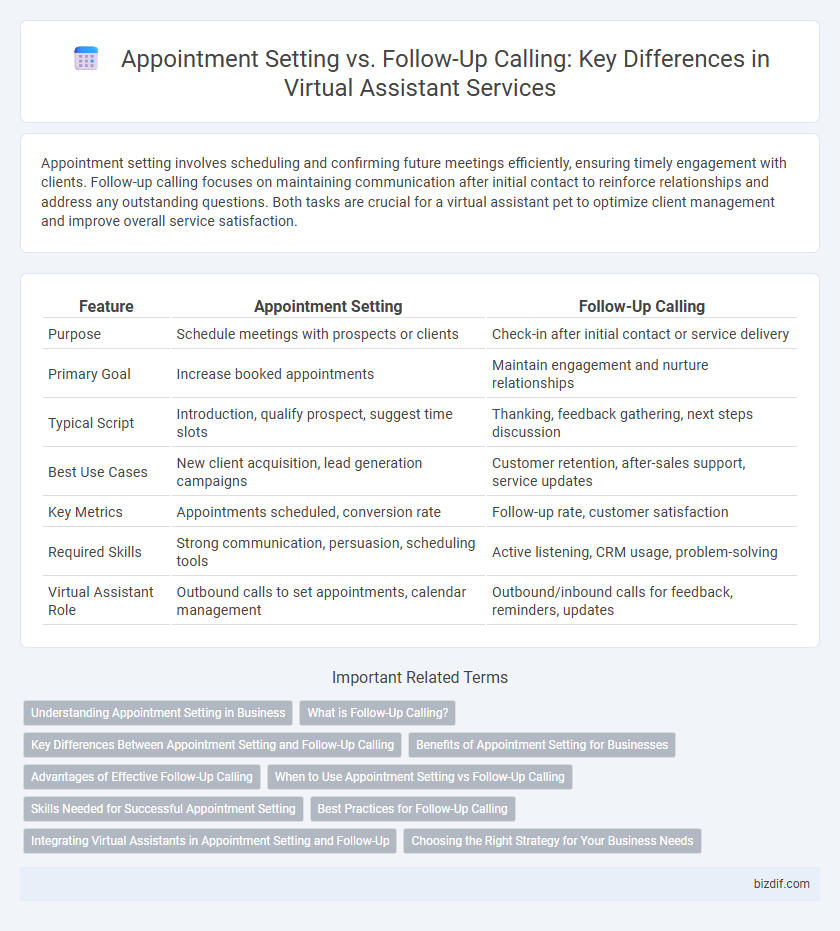Appointment setting involves scheduling and confirming future meetings efficiently, ensuring timely engagement with clients. Follow-up calling focuses on maintaining communication after initial contact to reinforce relationships and address any outstanding questions. Both tasks are crucial for a virtual assistant pet to optimize client management and improve overall service satisfaction.
Table of Comparison
| Feature | Appointment Setting | Follow-Up Calling |
|---|---|---|
| Purpose | Schedule meetings with prospects or clients | Check-in after initial contact or service delivery |
| Primary Goal | Increase booked appointments | Maintain engagement and nurture relationships |
| Typical Script | Introduction, qualify prospect, suggest time slots | Thanking, feedback gathering, next steps discussion |
| Best Use Cases | New client acquisition, lead generation campaigns | Customer retention, after-sales support, service updates |
| Key Metrics | Appointments scheduled, conversion rate | Follow-up rate, customer satisfaction |
| Required Skills | Strong communication, persuasion, scheduling tools | Active listening, CRM usage, problem-solving |
| Virtual Assistant Role | Outbound calls to set appointments, calendar management | Outbound/inbound calls for feedback, reminders, updates |
Understanding Appointment Setting in Business
Appointment setting in business involves proactively contacting potential clients to schedule meetings, ensuring a structured sales pipeline and increasing conversion rates. Virtual assistants specialize in this task by using targeted communication strategies and CRM tools to manage leads efficiently. Follow-up calling complements appointment setting by nurturing relationships, tracking progress, and reinforcing client interest after the initial contact.
What is Follow-Up Calling?
Follow-up calling involves contacting clients or prospects after an initial interaction to reinforce relationships, clarify details, or encourage action, essential for maintaining engagement and boosting conversion rates. Unlike appointment setting, which primarily schedules meetings, follow-up calls focus on nurturing leads and addressing any questions or concerns to move them closer to a decision. Effective follow-up calling enhances customer satisfaction and increases the likelihood of successful sales outcomes in virtual assistant services.
Key Differences Between Appointment Setting and Follow-Up Calling
Appointment setting involves scheduling meetings between clients and service providers, focusing on securing and confirming initial engagements. Follow-up calling centers on maintaining client relationships by checking in post-meeting to address questions, reinforce value, or encourage next steps. Key differences include the primary objective, timing in the sales cycle, and communication tone, with appointment setting being proactive and introductory, while follow-up calling is reactive and nurturing.
Benefits of Appointment Setting for Businesses
Appointment setting enhances business efficiency by streamlining client scheduling and reducing no-shows through automated reminders. It increases customer engagement by securing confirmed meetings, which drives higher conversion rates and sales growth. Optimizing appointment setting saves valuable time for staff, allowing focus on core business activities and improving overall productivity.
Advantages of Effective Follow-Up Calling
Effective follow-up calling enhances client retention by reinforcing initial interactions and addressing unresolved issues, which improves overall customer satisfaction. It boosts conversion rates by reminding prospects about appointments and demonstrating personalized attention, fostering trust and commitment. Timely follow-ups also provide valuable feedback that helps refine service offerings and optimize appointment-setting strategies for better results.
When to Use Appointment Setting vs Follow-Up Calling
Appointment setting is ideal for initiating contact with potential clients by scheduling meetings or consultations to establish a new business relationship. Follow-up calling is more effective after initial contact has been made to nurture leads, address questions, and reinforce interest in products or services. Use appointment setting to secure a time-specific commitment and follow-up calling to maintain engagement and move prospects through the sales funnel.
Skills Needed for Successful Appointment Setting
Successful appointment setting requires strong communication skills, active listening, and persuasive abilities to engage prospects effectively. Mastery of time management and CRM software ensures efficient scheduling and tracking of appointments. Follow-up calling skills focus more on persistence, rapport-building, and addressing client concerns to convert potential leads into confirmed meetings.
Best Practices for Follow-Up Calling
Effective follow-up calling involves timely contact within 24-48 hours after the initial appointment setting to reinforce engagement and address any client questions. Personalizing the conversation based on the previous interaction increases response rates and builds trust. Utilizing CRM tools to track follow-up schedules and notes ensures consistency and improves overall communication efficiency.
Integrating Virtual Assistants in Appointment Setting and Follow-Up
Integrating virtual assistants in appointment setting streamlines scheduling by efficiently managing calendars, sending reminders, and reducing no-shows through automated confirmations. For follow-up calling, virtual assistants track client interactions and deliver personalized messages to nurture leads and enhance customer retention. Leveraging AI-driven virtual assistants in these processes boosts productivity, ensures timely communication, and improves overall customer experience.
Choosing the Right Strategy for Your Business Needs
Appointment setting targets initial contact to secure meetings, driving new client acquisition and lead generation. Follow-up calling nurtures existing prospects, increasing conversion rates and customer retention through personalized communication. Businesses should evaluate their sales cycle stage and customer engagement goals to select the strategy that maximizes return on investment and supports long-term growth.
Appointment setting vs Follow-up calling Infographic

 bizdif.com
bizdif.com